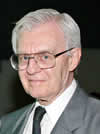Jerzy Adam Dobrowolski
About Optica
In Memoriam: Jerzy Adam Dobrowolski,
12 February 2013
In Memoriam: J. A. Dobrowolski, 1931-2013
 Jerzy (‘George’) Adam Dobrowolski, a well-known pioneer in the field of optical thin films, died peacefully on 12 February 2013 in Ottawa, Canada, at the age of 81.
Jerzy (‘George’) Adam Dobrowolski, a well-known pioneer in the field of optical thin films, died peacefully on 12 February 2013 in Ottawa, Canada, at the age of 81.
George worked for his entire professional career at the National Research Council of Canada (NRC) and made a number of significant contributions to the science and applications of thin films. George was an OSA Fellow Emeritus and received the OSA Joseph Fraunhofer Award in 1987 for "the development of numerical methods for the automatic design of optical multilayer coatings with pre-defined spectral characteristics, as well as methods for their practical realization." In 1996 he was additionally honoured with the David Richardson Medal, for his contributions to "the invention and development of optical thin film security coatings for the protection of documents and paper currency." In 1989 he was awarded the Moet Hennessy-Louis Vuitton "Science pour l'Art" Price, and he received the Canadian Association of Physicists Medal of Achievement in Industrial and Applied Physics in 1997. In 2005 George received the Nathaniel Sugerman Memorial Award of Society of Vacuum Coaters in recognition of his continuing significant contributions to knowledge of optical coatings, in design, manufacture, and applications. In 2004 he received the ultimate honour for contributions to Canada, becoming a Member of the Order of Canada.
George was the author of over 190 papers, over 30 patents and 8 review chapters in books. George was a founding member of the Optical Interference Coating Conference and was actively involved in chairing or organizing other international conferences on optical coatings. George also loved to give talks and courses on optical coatings all over the world to scientists, engineers and technicians who have all benefited from his knowledge of optical coating design and deposition.
George was born in Poland in 1931 and had a happy childhood until the start of WW II when George’s father left to fight in the Polish Army. In 1947, George’s father was able to bring over his wife and son to England. There, George attended grammar school not knowing any English, but within a year, he was speaking English and became completely immersed in English culture. George’s university years were impressive: he obtained his B.Sc., M.Sc. and Ph.D. degrees within a period of five years at London’s Imperial College. His Ph.D. thesis was entitled “Aspherisation by Vacuum Evaporation” and his supervisor was the well-known optical physicist Dr. Walter Welford. After his graduation in 1955, George went to the NRC for a two-year post-doc. After the end of the first year, George was offered a “permanent position” - a term that for once actually meant what it said, for George was to have an office at the NRC from 1955 to 2013.
His first project at the NRC was to make extremely narrow bandpass filters (less than 0.1 nm bandwidth). This set the stage for the next 58 years, where George went on to pioneer numerous advances in the field of optical thin films. George became interested in optical filter design and developed a number of thin film optimization methods over the years. In 1965, he developed the first completely automated thin film synthesis program where no initial thin film design was required.
From the late 1960s through the 1990s, George built up a world-class thin films group at the NRC that specialized in the areas of optical design, fully automated thin film filter deposition and innovative optical filters. George is perhaps best known for the development of the thin film security device technology which culminated in the successful issue of Canadian banknotes with the anti-counterfeiting ‘thin film’ patch device in 1989.
George officially retired as a Principal Research Officer from the NRC in 1991 but then, for the next 22 years, as a NRC Researcher Emeritus, he continued going to the NRC to work with and mentor his younger colleagues. In 2006, there was a celebration of both George’s 75th birthday and his 50th anniversary at the NRC. Scientists from all over the world attended a workshop and banquet dedicated to George. George has left the optical community a scientific legacy that will not soon be forgotten.
This memoriam would not be complete without a reference to the personal qualities that made George Dobrowolski such a special friend and colleague to many around the world: his passion for thin film science, his infectious enthusiasm, his integrity, his vision of science as transcending political boundaries, his sense of communities and his willingness to help others. George has been described as an “old-school” scientist and a gentleman of the highest caliber. Invariably polite, he had a charming, old-fashioned manner (he wore a suit and tie most days of his life). He will be sorely missed by all of his friends and colleagues.
George leaves behind a loving family – three children and seven grandchildren. George had a fulfilling life and those of us who have known him are much the richer for it.
This obituary was prepared by Brian T. Sullivan, Li Li and Peter Dawson
